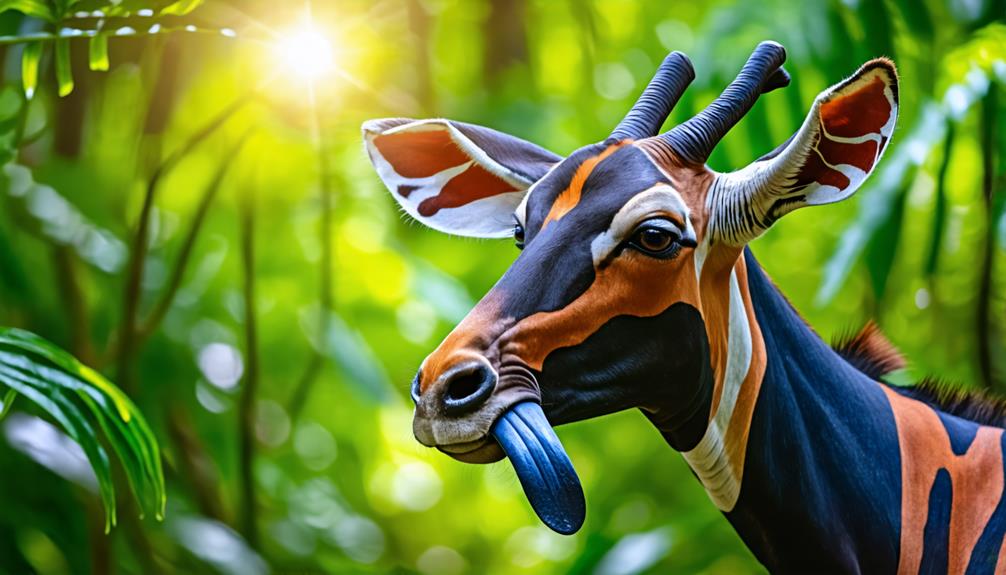You might think that having a tongue long enough to wash your own eyelids would be an odd trait, but for okapis, it's a remarkable adaptation. These elusive relatives of giraffes possess tongues that can stretch up to 14 inches, serving dual purposes of feeding and grooming. While it's easy to focus on the peculiarity of this feature, there's more to the okapi's tongue than meets the eye. Its unique length and prehensile nature play significant roles in the animal's survival, offering advantages that go beyond mere curiosity. Let's explore how this extraordinary appendage shapes the okapi's life in the dense forests of Central Africa.
Key Takeaways
- Okapi tongues stretch 12 to 14 inches long, enabling them to reach their eyes and ears.
- The prehensile nature of their tongue allows for precise control during grooming activities.
- Okapis use their long tongues as a grooming tool for cleaning their eyes and eyelids.
- Their tongue's length and flexibility provide a feeding advantage in accessing high foliage.
Tongue Length and Functionality

Stretching an impressive 12 to 14 inches, the okapi's long, prehensile tongue is a marvel of evolutionary adaptation. You'll find this unique feature perfectly suited for the okapi's herbivorous diet in the dense rainforests of Central Africa. Their remarkable tongue allows them to reach high foliage that other herbivores can't access, giving them a distinct advantage in their ecosystem.
But the okapi's long tongue isn't just for feeding. It's also an important grooming tool. You'd be amazed to see how they use their tongues to clean their eyes and ears, maintaining vital hygiene in their humid forest habitat.
This versatility showcases the okapi's remarkable adaptation to its environment. With a bluish-gray color resembling a serpent's tongue, this extraordinary appendage exemplifies nature's ingenuity in equipping species for survival in challenging habitats.
Anatomical Adaptations for Grooming
You'll find that the okapi's remarkable tongue isn't just for feeding; it's a multipurpose tool perfectly adapted for grooming in their dense rainforest habitat. These long tongues, measuring up to 14 inches, allow okapis to clean hard-to-reach areas like their eyes and ears. The blueish-gray color of their tongues is unique among mammals, resembling that of a serpent.
| Adaptation | Purpose | Benefit |
|---|---|---|
| Long tongue | Grooming | Enhanced hygiene |
| Prehensile structure | Foraging | Access to high leaves |
| Blueish-gray color | Camouflage | Predator avoidance |
| Self-cleaning ability | Infection prevention | Improved health |
These anatomical adaptations are vital for okapis' survival in dense rainforests. By maintaining cleanliness, they reduce the risk of infections. The versatility of their tongues not only aids in grooming but also allows them to reach leaves and fruits high in the canopy, making it an essential tool for both hygiene and nutrition.
Unique Feeding Behaviors

While the okapi's tongue serves as a remarkable grooming tool, it's also central to their unique feeding behaviors in the dense rainforest.
You'll find that these relatives of giraffes use their long, prehensile tongues to reach and manipulate leaves and branches effectively. Okapis are herbivores, consuming over 100 different plant species, including leaves, fruits, and flowers. Their diet is surprisingly diverse, as they've adapted to eat 40 to 65 pounds of food daily.
What's truly fascinating is that okapis don't stop at plants. They've developed some peculiar habits to aid their digestion. You'll be surprised to learn that they eat bat guano, clay, and even burned wood. These unusual dietary choices provide essential minerals and help process their fibrous meals.
It's clear that the okapi's feeding behaviors are as unique as their ability to wash their eyelids with their tongues.
Conclusion
You've discovered the okapi's incredible secret weapon: its astonishingly long tongue.
It's not just for reaching leaves; it's a multi-purpose tool for survival. You'll be amazed at how these animals use their tongues to clean their eyes, preventing infections in their humid habitat.
Next time you're in awe of nature's adaptations, remember the okapi's tongue. It's a perfect example of how evolution can create unexpected solutions to life's challenges.

Leave a Reply